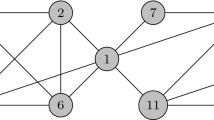Abstract
Detecting and analyzing dense subgroups or communities from social and information networks has attracted great attention over last decade due to its enormous applicability in various domains. A number of approaches have been made to solve this challenging problem using different quality functions and data structures. A number of cohesive structures have been defined as a primary element for community discovery in networks. Unfortunately, most of these structures suffer from computational intractability and they fail to mine meaningful communities from real-world graphs. The main objective of the paper is to exploit some cohesive structures in one unified framework to detect high-quality communities in networks. First, we revisit some existing subgraph models by showing their limits in terms of cohesiveness, which is an elementary aspect in graph theory. Next, to make these structures more effective models of communities, we focus on interesting configurations that are larger and more densely connected by fulfilling some new constraints. The new structures allow to ensure a larger density on the discovered clusters and overcome the weaknesses of the existing structures. The performance studies demonstrate that our approach significantly outperform state-of-the-art techniques for computing overlapping communities in real-world networks by several orders of magnitude.
Access this chapter
Tax calculation will be finalised at checkout
Purchases are for personal use only
Similar content being viewed by others
Notes
- 1.
Similar results have been seen for NMI metric.
References
Adamcsek, B., Palla, G., Farkas, I.J., Derényi, I., Vicsek, T.: Cfinder: locating cliques and overlapping modules in biological networks. Bioinformatics 22(8), 1021–1023 (2006)
Akbas, E., Zhao, P.: Truss-based community search: a truss-equivalence based indexing approach. Proc. VLDB Endow. 10(11), 1298–1309 (2017)
Akiba, T., Iwata, Y., Yoshida, Y.: Linear-time enumeration of maximal k-edge-connected subgraphs in large networks by random contraction. In: CIKM, pp. 909–918 (2013)
Alba, R.D.: A graph-theoretic definition of a sociometric clique. J. Math. Sociol. 3, 113–126 (1973)
Chakraborty, T., Srinivasan, S., Ganguly, N., Mukherjee, A., Bhowmick, S.: On the permanence of vertices in network communities. In: SIGKDD, pp. 1396–1405 (2014)
Chang, L., Yu, J.X., Qin, L., Lin, X., Liu, C., Liang, W.: Efficiently computing k-edge connected components via graph decomposition. In: SIGMOD, pp. 205–216 (2013)
Fang, Y., Huang, X., Qin, L., Zhang, Y., Zhang, W., Cheng, R., Lin, X.: A survey of community search over big graphs. VLDB J. 29, 1–40 (2019). https://doi.org/10.1007/s00778-019-00556-x
Fortunato, S.: Community detection in graphs. CoRR abs/0906.0612 (2009)
Girvan, M., Newman, M.E.J.: Community structure in social and biological networks. Proc. Natl. Acad. Sci. 99(12), 7821–7826 (2002)
Jabbour, S., Mhadhbi, N., Raddaoui, B., Sais, L.: Triangle-driven community detection in large graphs using satisfiability. In: AINA, pp. 437–444 (2018)
Jabbour, S., Mhadhbi, N., Raddaoui, B., Sais, L.: A declarative framework for maximal k-plex enumeration problems. In: AAMAS (2022)
Lancichinetti, A., Fortunato, S., Kertesz, J.: Community detection algorithms: a comparative analysis. New J. Phys. 11 (2009)
Leskovec, J., Krevl, A.: SNAP Datasets: stanford large network dataset collection. http://snap.stanford.edu/data (2014)
Leskovec, J., Lang, K.J., Mahoney, M.W.: Empirical comparison of algorithms for network community detection. In: WWW, pp. 631–640 (2010)
Luce, R.D.: Connectivity and generalized cliques in sociometric group structure. Psychometrika 15(2), 169–190 (1950). https://doi.org/10.1007/BF02289199
Lusseau, D., Schneider, K., Boisseau, O., Haase, P., Slooten, E., Dawson, S.: The bottlenose dolphin community of doubtful sound features. Behav. Ecol. Sociobiol. 54(4), 396–405 (2003). https://doi.org/10.1007/s00265-003-0651-y
Prat-Pérez, A., Dominguez-Sal, D., Larriba-Pey, J.: High quality, scalable and parallel community detection for large real graphs. In: WWW, pp. 225–236 (2014)
Saito, K., Yamada, T., Kazama, K.: Extracting communities from complex networks by the k-dense method. IEICE Transactions 91–A(11), 3304–3311 (2008)
Seidman, S.B.: Network structure and minimum degree. Soc. Netw. 5(3), 269–287 (1983)
Wang, J., Cheng, J.: Truss decomposition in massive networks. In: ACM (2013)
Wang, J., Cheng, J., Fu, A.W.C.: Redundancy-aware maximal cliques. In: ACM (2013)
Zachary, W.W.: An information flow model for conflict and fission in small groups. J. Anthropol. Res. 33, 452–473 (1977)
Yang, J., Leskovec, J.: Overlapping community detection at scale: a nonnegative matrix factorization approach. In: WSDM, pp. 587–596 (2013)
Yang, J., McAuley, J.J., Leskovec, J.: Community detection in networks with node attributes. In: ICDM, pp. 1151–1156 (2013)
Author information
Authors and Affiliations
Corresponding author
Editor information
Editors and Affiliations
Rights and permissions
Copyright information
© 2022 The Author(s), under exclusive license to Springer Nature Switzerland AG
About this paper
Cite this paper
Jabbour, S., Kmimech, M., Raddaoui, B. (2022). Discovering Overlapping Communities Based on Cohesive Subgraph Models over Graph Data. In: Wrembel, R., Gamper, J., Kotsis, G., Tjoa, A.M., Khalil, I. (eds) Big Data Analytics and Knowledge Discovery. DaWaK 2022. Lecture Notes in Computer Science, vol 13428. Springer, Cham. https://doi.org/10.1007/978-3-031-12670-3_16
Download citation
DOI: https://doi.org/10.1007/978-3-031-12670-3_16
Published:
Publisher Name: Springer, Cham
Print ISBN: 978-3-031-12669-7
Online ISBN: 978-3-031-12670-3
eBook Packages: Computer ScienceComputer Science (R0)




